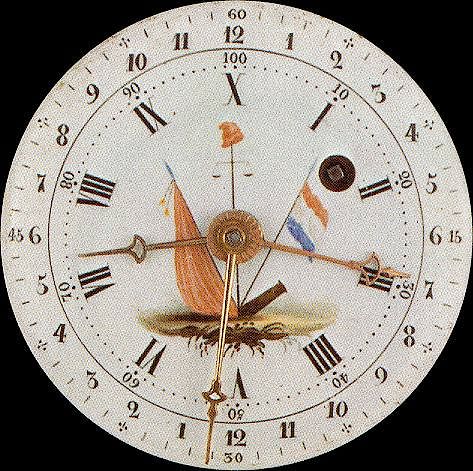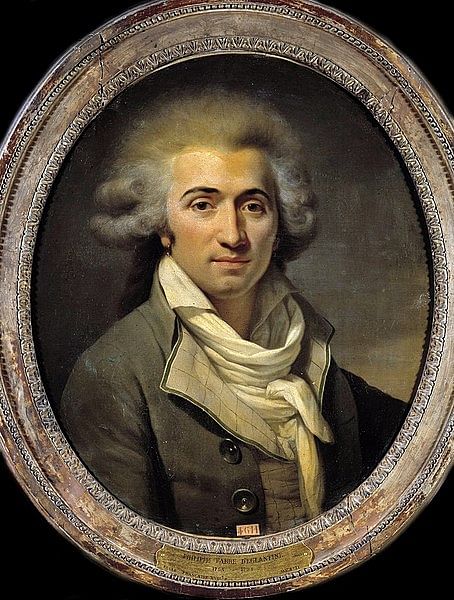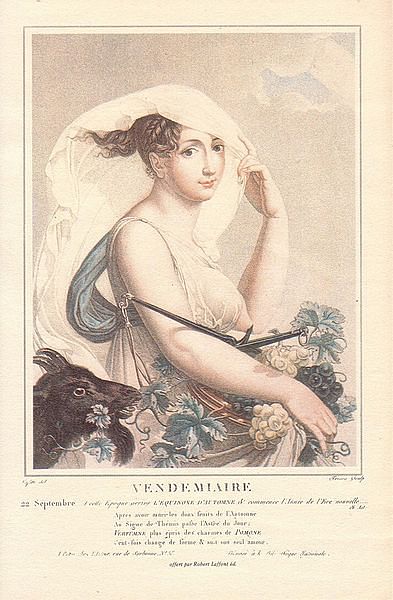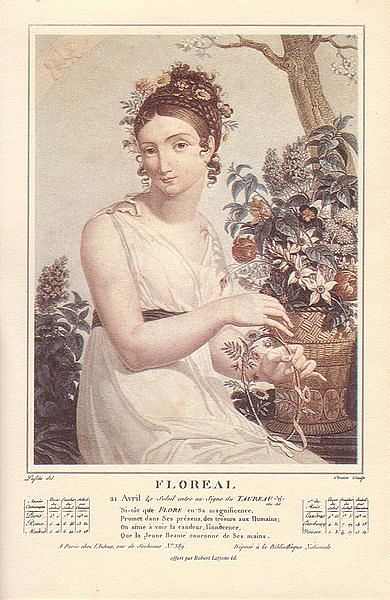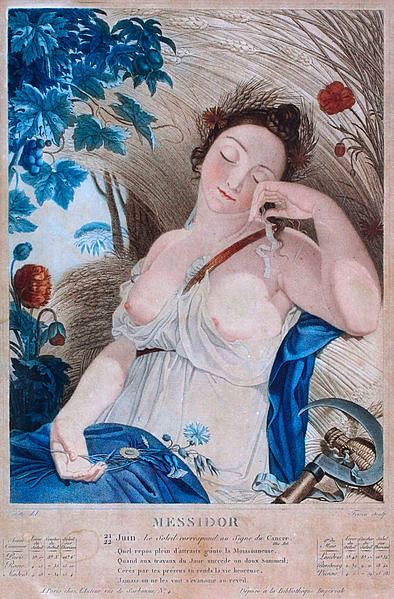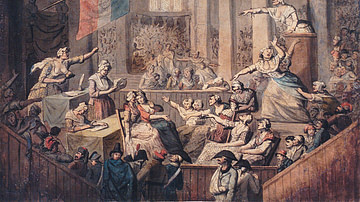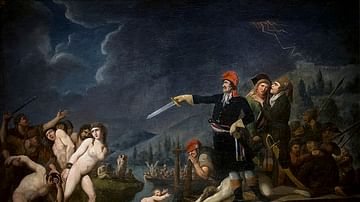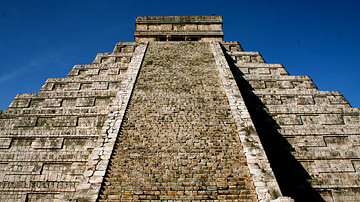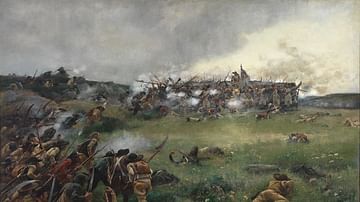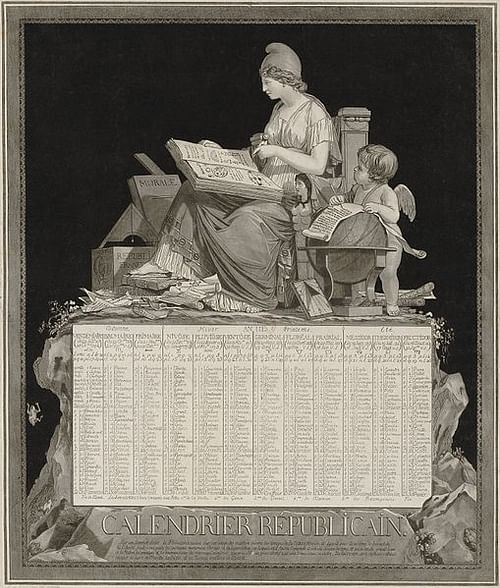
The French Republican Calendar, also known as the French Revolutionary calendar, was created during the French Revolution (1789-1799) in an attempt to build a new society separate from the vestiges of the Ancien Régime. First implemented in 1793, the calendar remained in use for twelve years until 1806 and was revived for 18 days during the Paris Commune of 1871.
The Republican calendar was designed to remove all royalist and Christian elements from the French calendar, which were replaced by natural and agricultural motifs. This is apparent in the poetic names of the months, derived from the most prominent characteristic of each month. For example, the month of Thermidor, which lasted from mid-July to mid-August in the Gregorian calendar, was derived from the Greek word thermon or "summer heat." The calendar is also notable for its use of decimal time. Each week consisted of ten days, and each day consisted of ten hours. An hour was made up of 100 decimal minutes, which were in turn divided into 100 decimal seconds.
Although it is often referred to as the Revolutionary calendar, this title is slightly misleading, as the calendar does not date from the start of the French Revolution in 1789, though this idea was indeed suggested. Instead, the calendar celebrates the birth of the French Republic, beginning with 22 September 1792 as the first day of the first year. From its adoption on 24 October 1793, the calendar persisted into the period of the First French Empire before it was finally abolished on 1 January 1806.
Origins
From its beginnings, the French Revolution was obsessed with destroying all traces of Ancien Régime society, which was viewed as corrupt, archaic, and oppressive. These changes ranged from mountainous societal reforms such as the dismantling of feudalism and the abolition of the monarchy, to less dramatic, though no less significant, measures such as the introduction of the metric system. Yet perhaps no change indicated the revolutionaries' intentions to build a completely new society quite like the Republican calendar, first introduced in October 1793.
Of course, the idea of scrapping the old calendar and declaring a new era of liberty predated the Republican calendar by several years. As early as 15 July 1789, the day after the Storming of the Bastille, enthusiastic citizens were already dating their journal entries and letters as "the second day of freedom" (Furet, 539). As the National Assembly continued making rapid reforms throughout that revolutionary summer, calls began to mount for the year 1789 to officially be declared Year I of the Era of Liberty and that 14 July mark the start of each new year.
This idea did not sit right with everyone, however, since many people saw no reason to drastically alter their perception of time by placing New Year's Day in the middle of summer. This led to disagreement between revolutionary-minded citizens; some suggested that the first day of the second year of Liberty begin on 1 January 1790, rather than 14 July of that year. This discrepancy only caused confusion, as the year that followed the Storming of the Bastille was variably referred to as either 1790, Year I of Liberty, or Year II of Liberty, depending on who was asked.
Inevitably, this led to issues regarding what dates to put on financial transactions, forcing the Legislative Assembly to confront the problem in January 1792. After substantial debate, the Assembly formally decided that 1 January would remain the start of the new year, to avoid falling out of step with other European calendars. Henceforth, all official documents were to be dated using the era of Liberty, which was proclaimed to have begun on 1 January 1789, though in practice, the Gregorian calendar was still more widely used.
The issue would arise again when, nine months later, the First French Republic was established. Almost immediately, the new legislating body, the National Convention, was bombarded with a flurry of petitions asking that 21 September be recognized as the new New Year's Day to commemorate the birthdate of the Republic. This ignited debate over whether France should date itself from the start of the Revolution, the birth of the Republic, or some other consequential anniversary. In January 1793, hoping to finally put the matter to rest, the Convention ordered the Committee of Public Instruction to prepare a report on "the advantages to accrue to France from bringing the common era in harmony with the republican era" (Furet, 539).
Creating a Calendar
What was supposed to be a relatively quick report took the committee nine months to complete. Rather than stick to their orders to reconcile the Gregorian calendar with France's republican era, the committee decided to ditch the old calendar entirely and create a new one from scratch. This decision was reached partially due to efforts by the Jacobin-controlled Convention to dechristianize society. Christianity was undeniably at the heart of the old calendar, which centered around the birth of Jesus Christ, thereby implying that to be the defining event in human history. Moreover, to bring the French people out from under the 'superstitions' of Christianity and into the fold of Enlightened 'Reason', the whole structure of the year would have to change. If left alone, people would certainly be reminded of church every Sunday and holidays like Christmas every December.
Another reason the committee decided to overhaul the French calendar was simply because they believed they could create a more concise, more accurate alternative. Working alongside the Jacobin politicians were prominent scientists and mathematicians, such as Gaspard Monge and Joseph-Louis Lagrange, who lent their expertise to achieve this goal. Significantly, the committee decided to decimalize their year, on the basis that the decimal system was the most natural way of counting; human beings, after all, were naturally born with ten fingers on which to count.
To this end, the calendar was designed to have twelve months, each comprised of thirty days. These would be organized into three ten-day long weeks (called decades), which in turn would be split into ten-hour days. Hours were now 100 minutes long, and minutes were 100 seconds. A decimal hour was therefore equal to 144 conventional minutes, while a decimal minute was equal to 86.4 conventional seconds. By making the weekly day of rest every tenth day rather than every seventh, the committee also drastically reduced the number of non-working days, a reform that economists had long advocated for.
On 20 September 1793, the committee's director Charles-Gilbert Romme took the report to the National Convention. He recommended that the calendar should retroactively begin on 22 September 1792, a date that not only held real significance for being the first day after the declaration of the Republic but also symbolic significance as it was the autumnal equinox; as Romme himself proudly put it, "equality of day and night was marked in the sky," at the same time that "civil and moral equality were proclaimed by the representatives of the people" (Furet, 541). For the calendar's contents, Romme suggested it be based around historical events significant to the Revolution. For example, the month lasting from 19 June to 18 July was to be named Bastille, while the month of 19 July to 17 August would be called People to commemorate the Storming of the Tuileries Palace by the people on 10 August 1792.
On 5 October, the Convention accepted Romme's idea to turn 22 September 1792 into the first day of the new era but rejected his terminology as too strange and briefly experimented with an ordinal nomenclature for the calendar. This would quickly prove too unwieldy and tedious, as citizens were forced to mark the date with something like, "signed on the twentieth day of the first month of the second year of the Republic." Realizing this system was too confusing, the Convention next turned to the poet, playwright, and Jacobin politician Fabre d'Eglantine to name the months and days.
Rather than focusing on important people and events of the Revolution, Fabre designed his calendar to celebrate nature and the agricultural world in which the majority of French workers still resided. He divided the year into four parts, each to coincide with a natural season. Each month was given a poetic name meant to evoke the most prominent characteristic of that time of year. The names of the months were derived from French, Latin, or Greek, and the last three letters of each name were grouped by season. Fabre also assigned a different domestic animal to each quintidi (fifth day of the week), and every décadi (tenth and final day of the week) was given a different agricultural tool. In place of Christian saints and martyrs, the other days were dedicated to a variety of fragrant herbs.
The moralizing of the French Revolution was not entirely absent from Fabre's calendar, however. The last five days (or six on leap years) of the year were called sans-culottides, in reference to the revolutionary group, the sans-culottes. These would be holidays, each one named for a different trait valued by the Revolution: the feasts of Virtue, Genius, Labor, Recompenses, and Opinions. The sixth holiday that appeared every leap year would be the Feast of the Revolution. With this decided, the Republican calendar went into effect on 24 October 1793, which became 3 Brumaire Year II.
Names of Months & Days
The names, meanings, and lengths of the Republican months and weekdays as devised by Fabre d'Eglantine include:
AUTUMN
- Vendémiaire: month of vintage, derived from the Latin vindemia, or "grape harvest." First month of the year. Lasts from 22 September to 21 October.
- Brumaire: month of fog, derived from the French brume or "mist." Lasts from 22 October to 20 November.
- Frimaire: month of frost, derived from the French frimas, or "frost." Lasts from 21 November to 20 December.
WINTER
- Nivôse: month of snow, derived from the Latin nivosus, or "snowy." Lasts from 21 December to 19 January.
- Pluviôse: month of rain, derived from the Latin pluviosus, or "rainy." Lasts from 20 January to 18 February.
- Ventôse: month of wind, derived from the Latin ventosus, or "windy." Lasts from 19 February to 20 March.
SPRING
- Germinal: month of sprouting buds, derived from the Latin germen, or "bud." Lasts from 21 March to 19 April.
- Floréal: month of the flower, derived from the French fleur, or "flower." Lasts from 20 April to 19 May.
- Prairial: month of the meadow, from the French prairie, or "meadow." Lasts from 20 May to 18 June.
SUMMER
- Messidor: month of harvest, derived from the Latin messis or "corn harvest" and the Greek doron or "gift." Lasts from 19 June to 18 July.
- Thermidor: month of heat, derived from the Greek thermon or "summer heat." Lasts from 19 July to 17 August.
- Fructidor: month of fruits, from the Latin fructus, or "fruit." Final month of the year. Lasts from 18 August to 16 September.
DAYS OF THE WEEK
- Primidi (first day)
- Duodi (second day)
- Tridi (third day)
- Quartidi (fourth day)
- Quintidi (fifth day)
- Sextidi (sixth day)
- Septidi (seventh day)
- Octidi (eighth day)
- Nonidi (ninth day)
- Décadi (tenth and final day, meant for rest and celebration)
History of the Calendar
The Republican calendar, established by the Jacobins at the beginning of the Reign of Terror, remained in use throughout that period. Many of the central events that took place during the Terror were named after the Republican dates on which they occurred. Examples include the Law of 14 Frimaire, in which the Committee of Public Safety consolidated power; the Law of 22 Prairial, which allowed for the acceleration of executions; and 9 Thermidor, the date on which Maximilien Robespierre and his allies fell from power, bringing the Terror and Jacobin dominance to an end.
The reactionaries who took power in the wake of the Jacobins, who were themselves often referred to as Thermidorians, targeted the Republican calendar, which had become a reminder of Jacobin ideals. It was denounced by politician Jean-Denis Lanjuinais, who referred to it as the brainchild of tyrants who had "dared to change times and days" (Furet, 544). Curiously, during the same period of time, when other remnants of the Jacobin regime were done away with, the calendar remained in place, despite numerous petitions from citizens who wished to see it abolished. Its survival was partially thanks to certain influential members of the National Convention, who feared that abolishing the calendar would set a dangerous precedent in which other revolutionary accomplishments could be undone.
The calendar remained in place for eleven years after the fall of the Jacobins. Efforts were occasionally made to revitalize it, especially after the coup of 18 Fructidor Year V. Representatives sent letters to journalists, reminding them to use Republican dates in their articles, and municipal governments were asked to avoid holding festivals on old Christian holidays. Since many French workers had gone back to observing their rest days on the traditional Sunday rather than on décadi, the revolutionaries tried to incentivize them to observe the tenth day by ordering all celebrations, announcements, and national festivals to be held only on décadis. This had little effect, however; a study in Year VI found that "the people detest our national festivals," while another report released the following year admitted that
Sundays and Catholic holidays…have for some time been celebrated with as much pomp and splendor as before. The same cannot be said of the décadi, which is observed by only a small handful of citizens. The first to disobey the law are the wives of public officials, who dress up on the holidays of the old calendar and abstain from work more religiously than anyone else. (Furet, 545)
Thus began the Republican calendar's slow decline. In Year VIII (1799-1800), all revolutionary festivals and holidays were abolished with the exceptions of 14 July and 1 Vendémiaire (New Year's Day, or 22 September). Then, under the leadership of Napoleon Bonaparte, the Concordat of 1801 reestablished the Roman Catholic Church as an official institution in France, although it was not declared the official state religion. The Concordat also restored the Gregorian names of weekdays and reestablished Sundays as the official days of rest for government employees.
All other aspects of the Republican calendar, such as months and years, remained unchanged until 1 January 1806 (or 11 Nivôse Year XIV) when Napoleon, now reigning as Emperor of the French, had it abolished, officially restoring the Gregorian calendar. The Republican Calendar would remain dormant for over 60 years until it was briefly resurrected during the short-lived Paris Commune in 1871. It was used from 6-23 May 1871, or 16 Floréal to 3 Prairial Year LXXIX by the Republican calendar's reckoning.
Legacy
France's Republican calendar was not the only revolutionary calendar to have existed; the Russian Revolution saw the rise of the Soviet calendar, which experimented with five- and six-day work weeks, although it did not try to alter the rest of the Gregorian year. The French calendar is still well-known, for its bold attempt to radically reorganize the year, as well as for the poetic names of months. It is frequently referenced by historians when discussing events that took place while it was in use; for example, the coup in which Napoleon Bonaparte seized power is still generally referred to as the Coup of 18 Brumaire rather than the Coup of 9 November.
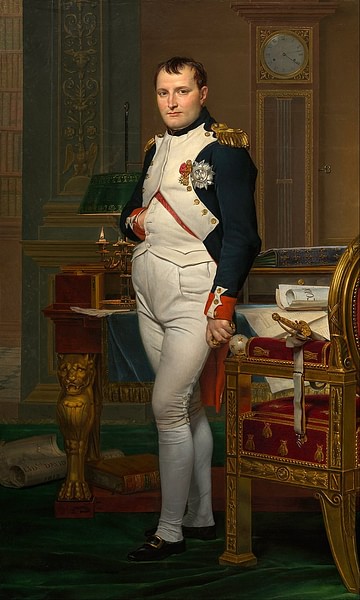
Coins minted during this period were marked with Republican dates, typically denoting the years with Arabic numerals rather than the Roman numerals commonly used in official documents (e.g. Year 3 rather than Year III). Briefly, clocks were manufactured to display decimal time. The use of decimal time was officially done away with in April 1795, long before the rest of the calendar was abolished. The rarity of these decimal clocks has turned those that have survived into priceless antiques.
The French Republican calendar symbolizes the efforts of the revolutionaries to completely upend society in their quest for a new era of liberty. Yet the ever-changing nature of the Revolution soon became incompatible with the calendar, structured around Republican patriotism and loathing for Christianity and the ways of the old world. Perhaps the best symbolic example of this is the fact that both of the calendar's principal authors, Fabre d'Eglantine and Charles-Gilbert Romme, were killed by the very Revolution they helped to promote; Fabre was executed by guillotine in 1794, Romme committed suicide a year later to avoid sharing the same fate. Yet the calendar also represented liberty itself, which perhaps helps explain why it lasted so long, surviving not only the Revolution but also the Republic it dated itself from.
